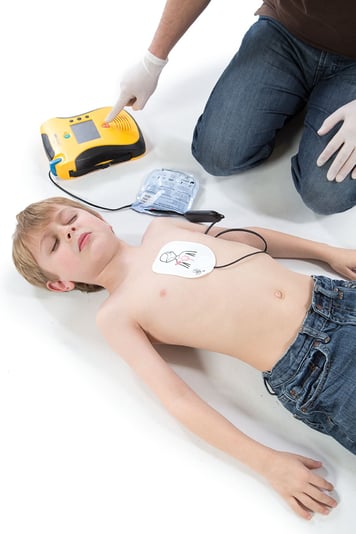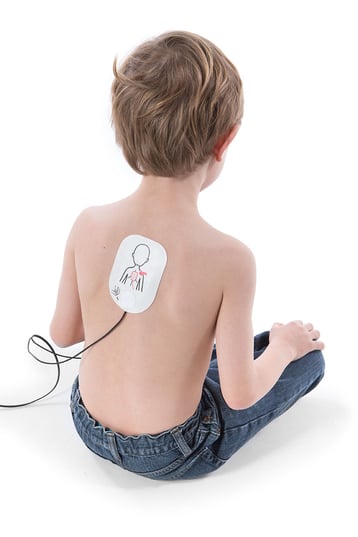Sudden Cardiac Arrest (SCA) affects anyone, regardless of age or health condition. Although we are not able to predict a sudden cardiac arrest, we are able to prepare for one by being equipped with a defibrillator.
Paediatric Care
A defibrillator provides suitable and effective treatment to a child through paediatric pads.
Electrode pad placement on a child is different to an adult, due to the chest and frame size of a child. One pad is placed on the centre of the child's chest, the other is placed on the centre of the child's back, adjacent to the front pad.
Paediatric electrode pads lower the shock to a safe level of joules for a child when restoring their heart back to a normal rhythm. In a situation where paediatric electrode pads are not available for a child in cardiac arrest, it is advised to use adult pads with the correct placement for a child.
A defibrillator with a built-in paediatric feature automatically adjusts the shock level at the touch of a button or switch. Paediatric pads will not be required if the device has a paediatric feature. The pads should still be placed on the centre of the child's chest and back.
Simply pressing the button or switch or inserting the key (dependent on the device) lowers the shock level, allowing vital time in an emergency by eliminating the need to detach and reattach a new set of electrode pads.


Defibrillators in Schools
Defibrillators should be as common as fire extinguishers as they save lives and should be regarded as an essential piece of equipment for all schools.
State-funded schools that are not already equipped with a life-saving defibrillator will receive one by the end of 22/23 academic year under new government plans to ensure there is a device in every school.
There is a 70% chance of survival if defibrillation occurs within 3 minutes of collapse and 90% if treatment is provided within one minute. Defibrillators in schools have the potential to save the lives of pupils, staff and visitors.
The chance of survival decreases by 10% for every minute that passes without treatment. Defibrillators in schools and staff who are trained in their use ensures immediate treatment is provided if someone were to suffer a cardiac arrest.
If more people become familiar with CPR and how to use a defibrillator, more lives will be saved. As of 2020, first aid has been a requirement in schools. This includes basic first aid for primary school children and secondary school pupils learn further first aid, such as how to administer CPR and the purpose of defibrillators.
Save a Life
Time is precious and every second counts when responding to an SCA emergency. Knowing how to effectively treat a child who has collapsed as a result of an SCA saves valuable time in an emergency and ultimately increases their chance of survival.
defibshop are committed to equipping everyone with the skills and knowledge to save a life. Speak to one of our Product Specialists on 0161 776 7422 or fill out our Contact Form.
Got further questions on SCA and defibrillators? Head on over to our FAQ page.






